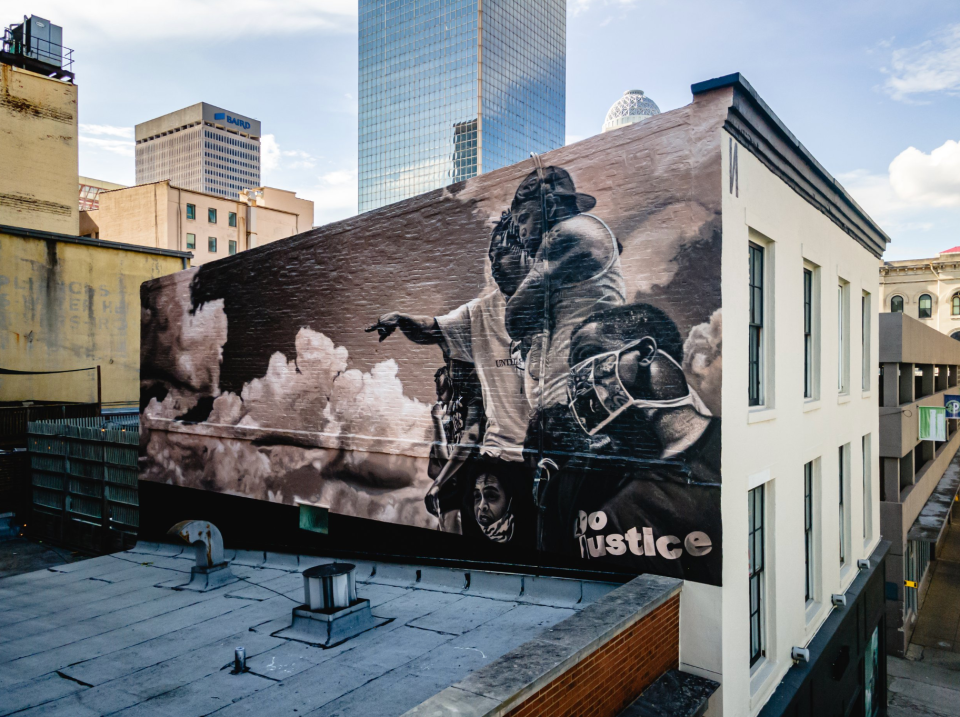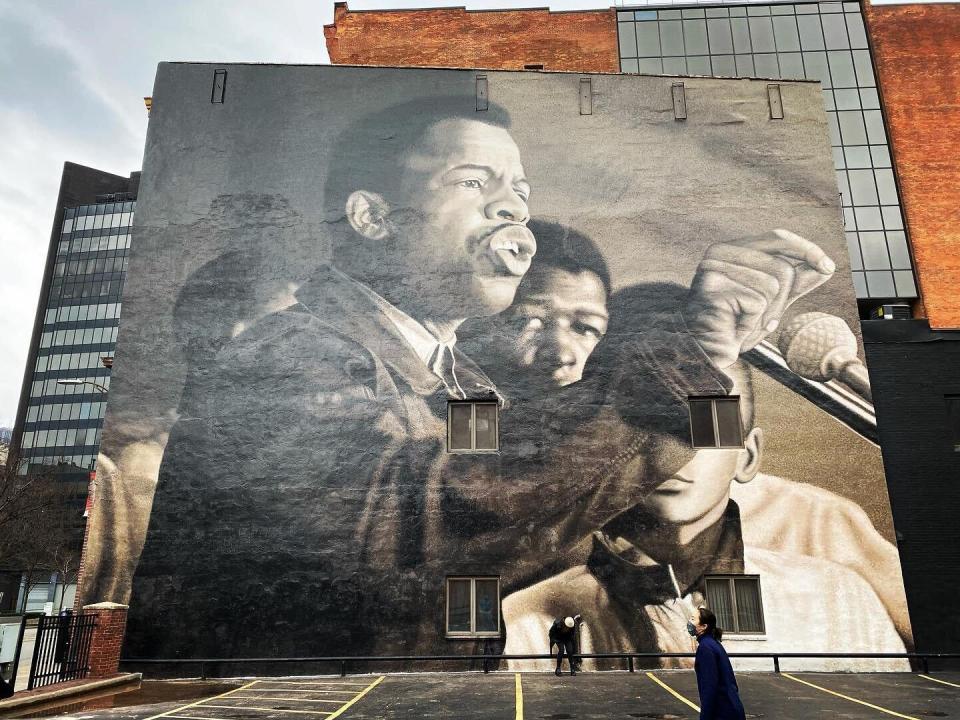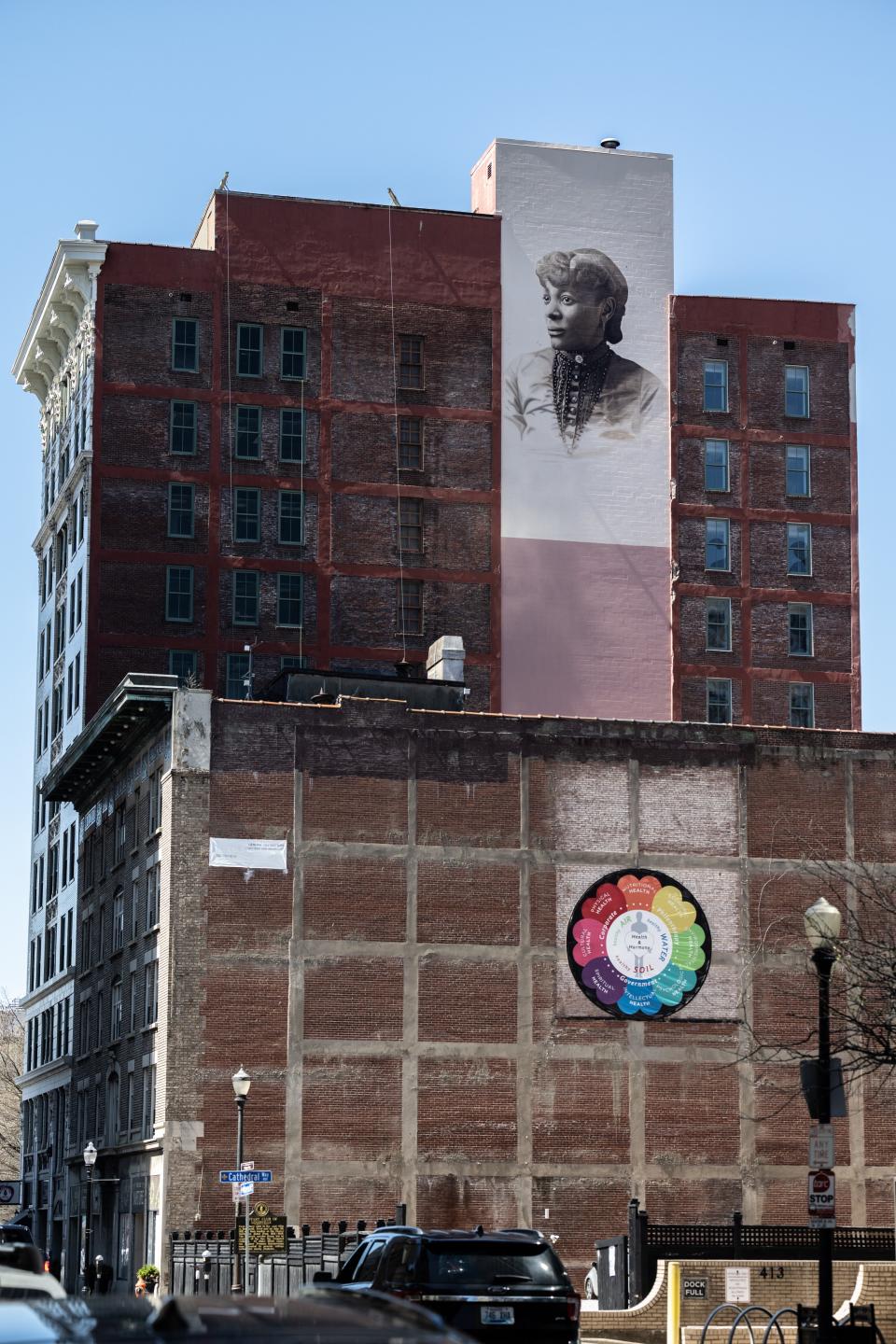Exploring the intersection of art, activism and social change in Utica's mural project
Alumni Jared Diaz returned to Pratt Munson recently to host an open forum for the “One World Garden” public art project.
The mural, funded by Rust2Green, will be located outside the Utica Dance building at 324 Genesee Street.
At the event, Diaz presented a digital rendering of the concept plan and then opened the floor up for public discourse. The theme is meant to reimagine city recreation with nature as the driving motif, he said.

According to Rust2Green Treasurer Lynne Mishalanie, the project started as a park proposal, designed by landscape architecture students at Cornell University, that never came to fruition.
The Oneida Square Arts District Association (OSADA) board said they felt the project was in good hands, describing it as “impressive, articulate, and accomplished.”
“With the understanding that Utica represents a vast range of people from diverse backgrounds, this project does not aim to create a broad or simplified vision of the community,” Diaz said. “Instead, this mural has room for individual contributions to shine.”
BIPOC perspective
Diaz is a second-generation Dominican artist, born and based in New York City. After earning his BFA from Pratt Institute in 2017 he went on to co-manage and execute the construction of over 2,000 murals nationwide.
Despite his experience with figuration and portraiture, he admitted its mural making has driven him to speak more and collaborate with others.
“When one situates themselves in alignment with relationships rooted in similar values, and mission-based initiatives, the universe tends to conspire in their favor,” he claimed.
Diaz referred to himself as an “institutional change maker.” As project manager for Mural Arts Philadelphia’s Public Art and Civic Engagement Initiative he's forged collaborations with other BIPOC artists and community-based organizations to help them achieve their goals.
Diaz noted the importance of being a BIPOC artist with agency over the built environment.
“I see the architectures of systemic racism and inequality around us as a kind of visual lyricality [a coined term]. I can infer from the visuals around me about what kind of experience I will have in a space.” … As a muralist I chose to privilege the underprivileged because I have the agency and responsibility to do so… And sometimes the final result is like a well deserved love song. There’s a beauty in acknowledging the unsung that's fundamentally equitable.”

Fresh approach
In response to the death of Brianna Taylor in March 2020, Diaz and his colleagues began to contemplate the best way to channel public momentum into art. Later that year, June 2020, after George Floyd was murdered they decided there was far too much urgency to wait any longer and launched their “I Am” mural series, Diaz explained.
The series spotlighted a Black man at a sanitation workers strike in 1968 with a sign around his neck that read: “I am a man.” The first mural was installed in the Wicker Park neighborhood of Chicago, the second in West Louisville.
Diaz said after the series wrapped up his team decided to lean into social change, through the lens of specific individuals.
In 2021, the face of Henrietta Helm – one of the first Black students to attend public school in the city and a celebrated educator – was painted to loom over downtown Louisville. After nine months of planning, community dialogues, and execution of the 1,500-square-foot mural-monument, the project was complete.

“There’s power in elevating her story, quite literally, 14 stories high in the sky,” said Diaz.“We started out looking through community archives for images and stories and discussing them with a few local community members directly invested in preserving and promoting the history of the Portland neighborhood. Upon hearing valid critiques about this work feeling extracted from the Portland neighborhood in Louisville and placed downtown, myself and my co-manager Katy Delahanty decided to donate half of our fee to start a seed fund for a scholarship in honor of Henreitta’s legacy.”
Taking that into consideration a scholarship was formed to aid Black women and femme educators enrolled in University of Louisville’s Teacher Residency Program.
“So we have cultural equity, uplifting a person of color who was a change maker in her community, and actually equity, mobilizing resources with a cause in mind,” Diaz acknowledged.
People, first
By keeping the public involved, Diaz said public reception has been overwhelmingly positive, across the board.
Nonetheless, anti-graffiti coating is applied to most of his mural’s to prevent tagging.
“I’m very grateful that through my career I’ve never seen a single pencil, sharpie, crayon, or spray on any of the murals I’ve created,” said Diaz. “There’s something that happens when you approach projects with sincerity and stay dedicated to a vision that actually matters to the public you’re serving. Your work is affirmed by how it's cared for by the community.”
During the Q&A portion of the event President and CEO of the Munson Museum of Art, Anna Tobin D'Ambrosio, brought up how difficult it was for people to adjust to the replacement of the Sunburst mural.
In response, Diaz pointed out he’s not afraid to lean into criticism and embraces involving the public in the decision-making process.
“Since public art can be so singular, especially in Utica, we tend to load it with a lot of expectations," Diaz said. "That being said, I understand that which is why I work the way that I do. Criticism presents itself as a challenge and I like to lean into the difficulty. I don’t want everyone to feel completely comfortable; if we’re comfortable we aren’t doing anything meaningful.”
What can Utica expect?
The Genesee Street mural will bring in photo realistic and romantic elements, slightly inspired by the Thomas Cole exhibit on display at the Munson Museum of Art, Diaz said.
The nature in the built environment – the sky above the roof and the trees bordering the parking lot – tie into the mural, making it appear as a continuation.
During the design process Diaz said he considered three main elements: interiority, exteriority, and allegory.
“I started off thinking about interiority, what a gathering space would look like if we reconstructed parts of the city to support communal intimacy. As well as exteriority, what Utica as a larger landscape would look like if it were augmented to support our relationship to nature and each other. I’m also interested in allegory and I saw this as an opportunity to explore ourselves individually, familially, communally, and ancestrally using nature as the prompt.”
In regards to next steps, Diaz said the project is currently in phase one, gathering public input. Moving into phase two he will conduct practical workshops at Munson to inform the final design.
Pre-production and production will follow shortly after.
Diaz said he intends to have a final rendering by March/April, begin production in April, and complete the execution in June.
Public reaction
Several members of the OSADA board shared their excitement about the new mural.
Long pointed out the value of public art, even on public property.
“Art has the power to elicit a response in the viewer," Long said. "It can ignite an internal dialogue as well as inspire conversations with others. This mural is bound to draw attention to Munson and will be a catalyst for conversation.
Mary Murray said she was impressed by Diaz’s commitment to the community and excited to watch its benefits extend to the region.
Jeff Zarelli agreed, reiterating that Diaz’s people-first approach will make this project a success.
“This very experienced artist has not only created masterful murals in other cities but has always invested an exhaustive amount of quality time researching the many historical, current and developing elements that reveal the unique DNA of each neighborhood," he said. "His process is successful in that it absorbs public input and synthesizes those thoughts into the final creation.”
This article originally appeared on Observer-Dispatch: Utica's 'One World Garden' art project spotlights social change themes

